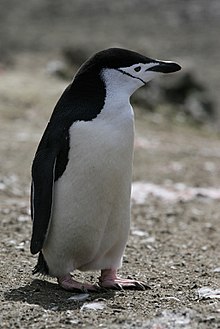Chinstrap penguin
| Chinstrap penguin | |
|---|---|

| |
| On Livingston Island, South Shetland Islands, Western Antarctica | |
| Scientific classification | |
| Kingdom: | |
| Phylum: | |
| Class: | |
| Order: | |
| Family: | |
| Genus: | |
| Species: | P. antarctica
|
| Binomial name | |
| Pygoscelis antarctica (Forster, 1781)
| |



The chinstrap penguin (Pygoscelis antarctica) is a species of penguin which is found in the South Sandwich Islands, Antarctica, Deception Island, the South Orkneys, South Shetland, South Georgia, Bouvet Island and Balleny. Their name derives from the narrow black band under their heads which makes it appear as if they are wearing black helmets, making them one of the most easily identified types of penguin. Other names for them are "ringed penguins", "bearded penguins", and "stonecracker penguins" due to their harsh call.
Description
Chinstrap penguins can grow up to 68 cm (27 in) in length, and a weight of 6 kg (13.2 lbs);[2] however, their weight can drop as low as 3 kg (6.6 lbs) depending on the breeding cycle. Males are both larger and heavier than females.[3][4]
The adult chinstraps' flippers are black with a white edge; the inner sides of the flippers are white. The face is white extending behind the eyes, which are reddish-brown; the chin and throat are white as well, while the short bill is black. The strong legs and the webbed feet are pink. The chinstrap penguin's black-and-white plumage helps camouflage it in the water from predators such as seals. When seen from above, the bird's black back blends into the dark water below, while the bird's underside blends into the sunshine above when seen from below.[5]
Their diet consists of krill, shrimp, fish, and squid which they swim up to 80 km (50 mi) offshore each day to obtain. The chinstrap penguin is able to withstand swimming in freezing waters due to its tightly packed feathers, which provide a waterproof coat. Thick blubber deposits provide insulation, as well, and blood vessels in the flippers and legs have evolved intricate structures to preserve heat.[5]
They live on barren islands and during winter congregate on large icebergs of the sub-Antarctic region and the Antarctic Peninsula; however, they require solid, snow-free ground for nesting. The chinstrap penguin's primary predator is the leopard seal. The 16 million chinstrap penguins have typical lifespans of 15–23 years.
Chinstrap penguins are considered the most aggressive species of the penguin.[6]
Predators
The predator of adult chinstraps is the leopard seal. Eggs and chicks can fall prey to birds, such as the sheathbill and the brown skua. Sea lions are their main predator. All of the chinstrap's predators are sea lions, orcas, skuas, leopard seal and sharks.
Behavior
On land they build circular nests from stones, and lay two eggs, which are incubated by both the male and the female for shifts of 6 days. The chicks hatch after about 37 days, and have fluffy gray backs and white fronts. The chicks stay in the nest for 20–30 days before they go to join a crèche. At around 50–60 days old, they moult, gaining their adult feathers and go to sea.
Roy and Silo
In 2004, two male chinstrap penguins named Roy and Silo in Central Park Zoo, New York City, formed a pair-bond and took turns trying to "hatch" a rock, for which a keeper eventually substituted a fertile egg, and the pair subsequently hatched and raised the chick. Penguins by nature hatch eggs and are social creatures. The children's book And Tango Makes Three was written based on this event.
References
- ^ Template:IUCN
- ^ Weight of Chinstrap Penguin.
- ^ http://www.mhcbe.ab.ca/St_Francis/gr1/Webquests/chinstrap_penguin%20student.htm
- ^ http://animaldiversity.ummz.umich.edu/site/accounts/information/Pygoscelis_antarcticus.html
- ^ a b "Chinstrap Penguin Fact Sheet, Lincoln Park Zoo".
- ^ http://www.theanimalfiles.com/birds/penguins/chinstrap_penguin.html

